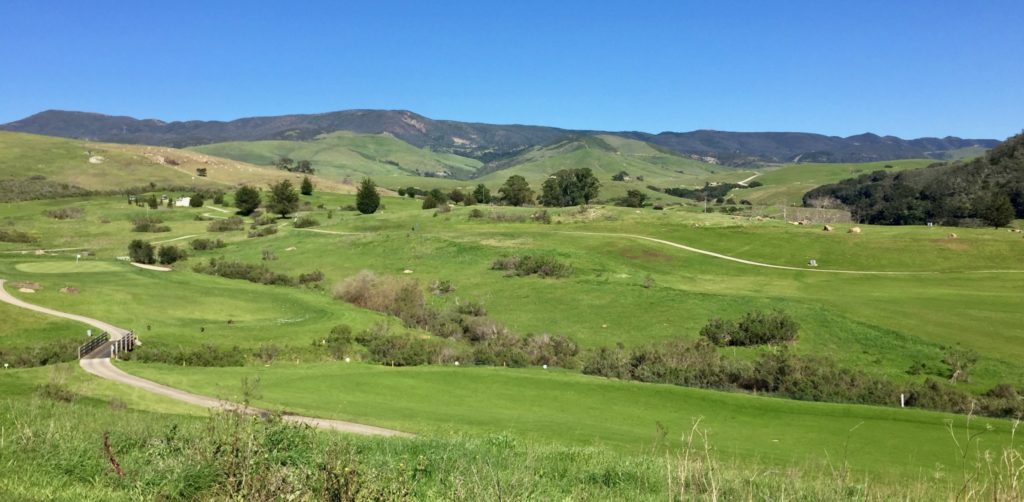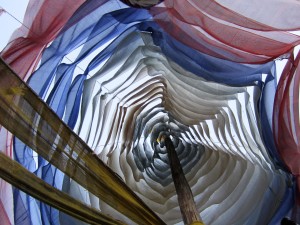 In between fetching pain pills and making me lunch, Gertrude watches me grimace every time I roll over. Or get up to go to the bathroom. Sneezing is the worst.
In between fetching pain pills and making me lunch, Gertrude watches me grimace every time I roll over. Or get up to go to the bathroom. Sneezing is the worst.
“No more golf for you,” she says.
I’m recovering ever-so-slowly from a bulging disk. The only comfortable position is lying on the floor on my stomach.
“We’ll see,” I say, reluctant to trade in my golf clubs for a swimsuit.
With nothing better to do, I search the Internet: Why is golf bad for your back? I discover that the twisting is hard enough on your spine, but add leaning over, and then occasionally slamming the club into the ground. Discs tear, little bony facets dig into the nerves, muscles inflame. Ouch. Ouch. Ouch.
It’s easy for Gertrude to be so glib about my golf days suddenly coming to a close. She doesn’t appreciate the hunt for that elusive hole-in-one. The occasional birdie. The ocean view from the tee box on five. The shared frustrations and inside jokes.
The life lessons.
 There are lessons to be learned from participating in anything you’re dedicated to and passionate about. Serving up the perfect crème brûlée. Rebuilding an old Corvette. The barista who fashioned this self-portrait in the latte foam.
There are lessons to be learned from participating in anything you’re dedicated to and passionate about. Serving up the perfect crème brûlée. Rebuilding an old Corvette. The barista who fashioned this self-portrait in the latte foam.
Here’s what I’ve learned from spending time out on the course:
Lesson #1: Don’t Narrate Your Bad Shots
At a golf lesson last summer, the instructor waxed eloquent about staying positive. I knew from watching him toss shots out that he didn’t have all that much to complain about.
“Don’t narrate your bad shots,” he told me.
Fair enough. What’s the point of griping about a putt you hit too hard? It’s pretty obvious the second your ball sails past the hole. But if you’re a golfer, you know how hard it is stay positive when an otherwise terrific drive lands in the water. Or you watch the six-foot clod of dirt fly further than your ball.
Because I can’t golf—for now—I’ve taken up sketching. I’ve always wanted to learn to draw, so I figure this is my opening. If you don’t overthink it, golf, like sketching, is pretty easy. You hit the ball—however many times it takes—until you get it into the little hole on the green. Isn’t drawing the same? You put paint or pencil or charcoal to paper. What’s the problem?
Like anything else, it’s the expectations we have, the dreams of perfection, the overanalyzing and tension that get in the way. We want a guarantee that we’ll achieve that elusive one-putt. Not just once, but multiple times each game. Like much of life, it’s a game of increasing greediness.
In a recent life drawing class, the model had been a tall, elegant black woman. At the end of class, I found myself leafing through the morning’s efforts. I could see that one drawing in particular, I’d done a fine job of capturing the curve of her spine, the shape of her hands resting on her thigh. I was pleased with my experiment of using watercolor to accent shadows. There was no sense bemoaning the other drawings—that lacked perspective, and held no resemblance to the model. Those drawings hadn’t turned out the way I’d hoped.
By chance, I remembered my golf teacher’s advice. Don’t narrate your bad shots, I thought. Besides, I’m just a beginner.
Aren’t we all beginners?
Lesson #2: Beginner’s Mind
Back in 1980, when I started graduate school in clinical psychology, I stumbled on the notion that I didn’t have to know anything. Wasn’t that the point of graduate school? That first anxious day, I remember looking around the classroom. Cramped in uncomfortable wooden desks were twenty of us pretending we weren’t surreptitiously sizing each other up. As it turned out, my beginner’s mind lasted well into the second semester and thank goodness. It meant I could be curious, that I was open to learning from my mistakes, that I didn’t have to pretend to be the next Anna Freud.
Unfortunately, by the second semester, my ego had wrangled me senseless and I’d begun to think I ought to know something. In fact, I’d convinced myself I ought to know quite a lot. It was a curse, siphoning off the joy of discovery, muting my creative impulses.
Of course, it’s hard to keep that beginner’s mind from morphing into something else. You begin to criticize, complain, carp. Throw your clubs. Break your colored pencils in half. For the time being, it’s just not that much fun.
If you don’t want to give up entirely, that’s when it’s important to locate the good.
Lesson #3: Locating the Good
It’s two weeks later and I’ve graduated from the floor to the couch. I’m taking short walks and beginning to believe there will be life after a bulging disc. I try working on a blog post, which turns out to be pointless given that my brain feels like overcooked squash. I can’t stay focused long enough to string more than a couple of words together.
Gertrude’s no help. “I don’t mean to hurt your feelings,” she says, “but what you’ve got so far? Well, it’s crap.”
Gertrude doesn’t really care about my feelings, but still, she’s right.
“What about that one good line?” I ask.
She knows which line I’m talking about. “Yeah,” she says. “That line really sings.”
If you’re willing to be brutally honest with yourself, it isn’t hard to find the one line that sings. It’s that relaxed golf swing that kisses the ball on the sweet spot. The splotch of color that draws in your attention.
Locating the good means relaxing and trusting the process. Trusting the one good line, the one moment of freedom and light that will move the poem or the drawing or your golf game forward. You have to set aside what isn’t working, knowing that with proper attention, something new and fresh will appear on the page.
In every shot. In every drawing. In every blog post or poem. Find the good, however small. And then trust that the rest will emerge.
Lesson #4: Trust Yourself
When I was learning to play golf, fearful that I was going to hit the ground, I’d tense up just before hitting the ball. Sure enough, even if I didn’t hit the ground, I’d hit a terrible shot. It was infuriating. One day, purely out of frustration, I just swung the club. “Whatever,” I thought. Then I watched the ball soar into the air. It was magic.
I’m a newbie at drawing, but I can see that if I’m tense or too worried about drawing the perfectly straight, dynamic line, that I’m going to metaphorically hit the ground. The first life drawing class I attended, I was pretty pleased with myself. I figured if anything even remotely looked like the model, I was doing pretty well. Three hours of focused attention flew by. The second class, my critical brain had already begun to hold court. I was looking around at what everyone else had done—and judging my feeble attempts. By the third class, it was clear that I’d completely deluded myself into believing I had anything akin to talent.
Trust yourself, I thought. Stop worrying about what anyone else is doing or thinking. Play your own game.
Lesson #5: Play Your Own Game
On my best days, I was a mediocre golfer. That’s not modesty. It’s the truth. I’d watch women ten years older, hell, twenty years older—hit a drive well past mine. I’d get frustrated, tense up. Determined to redeem myself, I’d swing that club as if an image of Individual #1 was embossed on those tiny dimples at the back of the ball. Then I’d hear the whishing sound of air, and I’d look down to see that the ball was still on the tee. In golf, a swing and a miss counts.
I’ll never be Annika Sorenstam. Or Picasso. Or Georgia O’Keefe. I read Toni Morrison with awe and a bit of dismay. I’m getting older and there aren’t going to be any Pulitzers or Nobel Prizes in my future.
But haven’t I succeeded if I can write a blog post that gets people talking? Or a sketch that’s pleasing to the eye and captures something of the figure’s likeness? What’s important is that I’ve brought everything I can to that one sentence or drawing or one shot. That I’ve played my own game.
No matter the lie.
Lesson #6: Play it as it Lies
Play it as it lies. It’s a familiar rule in golf. No matter how tall the grass. Or how deep the sand. Like a bulging disc, there are no mulligans.
It’s almost six months since I hurt my back and every morning I whine about the forty-five minutes of exercises I have to do to strengthen my core. But I do them anyway, and my oh-so-firm glutes are proof it’s paying off.
I’m working at a new standing desk, grateful to be standing and walking, swimming, hiking again. Grateful that I can string whole sentences together. Grateful to my wife and my friends and family, all of whom drove me around and went food shopping for me and visited and called to see how I was doing. My life is a great expansive privilege. But still, I miss playing golf. And there are plenty of days I bellyache about the physical challenges of the last six months. I have to remind myself that I’m very lucky indeed.
Maybe I’ll golf again. Maybe I won’t. But I’ll always be grateful to the game that taught me important lessons about optimism and trust and locating the good.
No matter how lucky—or lousy—the lie.



 ice. You know they’re watching your every step, languishing, unassuming, sluggish. Poised to snap off a few fingers or a foot. If you get too close.
ice. You know they’re watching your every step, languishing, unassuming, sluggish. Poised to snap off a few fingers or a foot. If you get too close. It makes you wonder how much the physical landscape of childhood molds our psyches. Sculpting the possibilities, limiting our vision. The simmering, relentless heat of the South. Ghosts and vampires and sorcery. Dank, claustrophobic spaces. Standing on the edge of a marsh in the Savannah Wildlife Refuge, I swear the reeds and the lil
It makes you wonder how much the physical landscape of childhood molds our psyches. Sculpting the possibilities, limiting our vision. The simmering, relentless heat of the South. Ghosts and vampires and sorcery. Dank, claustrophobic spaces. Standing on the edge of a marsh in the Savannah Wildlife Refuge, I swear the reeds and the lil y pads ached for a breath of wind, just enough to cause a ripple in the water.
y pads ached for a breath of wind, just enough to cause a ripple in the water.
 “What about your carbon footprint,” she says. Gertrude’s admonishing me with the wag of her finger. “Besides, why would you want to go anywhere else? We practically live in paradise.”
“What about your carbon footprint,” she says. Gertrude’s admonishing me with the wag of her finger. “Besides, why would you want to go anywhere else? We practically live in paradise.” But then I reassure myself that it’s a good thing. To be forced outside a routine. Grapple with discomfort. Expand my perspective.
But then I reassure myself that it’s a good thing. To be forced outside a routine. Grapple with discomfort. Expand my perspective.





 A number of years ago I practiced the piano every day,
A number of years ago I practiced the piano every day,